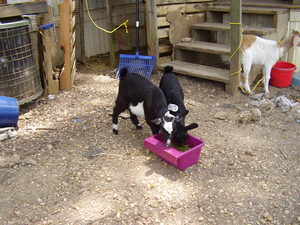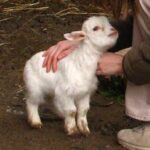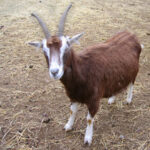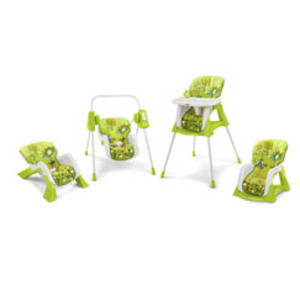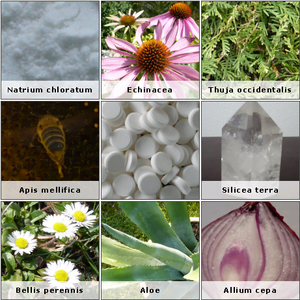There are many breeds and crosses of goats. The goat, being the adaptable animal she is, is at home browsing over a large pasture. She also can be content with plenty of food offered to her in a back yard. She’ll browse the grass but will need more than that to sustain growth and life. Still, for people with small areas who like goats – small breeds offer alternatives.
The Nigerian Dwarf is one small goat, with an emphasis on her dairy capabilities. While she won’t be producing a gallon and a half a day like her larger counterparts are capable of she also doesn’t eat as much. And for those who don’t use all that milk – and figuring goats are happiest with a buddy – you’ll have two capable of providing a home with milk. With good breeding and management she can produce two quarts per day with good butterfat and protein. The Nigerian Dwarf is a dimunitive version of a larger dairy goats, with a balanced proportion. The nose is generally straight with upright ears and any color is acceptable although pygmy coloration is discouraged. The ideal height of a Nigerian Dwarf is 17-19″ for does with up to 21″ allowed and bucks about 2 inches taller. Ideal weight is about 75 pounds. They are disqualified for showing signs of other breeds – myatonia, long ears, roman nosed or other traits not keeping with the standard. They are developed to be even tempered and can improve a pasture by eating undergrowth other livestock don’t eat. The Nigerian is a longer bodies dairy looking goat when compared to the pygmy.
Like all goats these small breeds should be kept in clean dry pens with good management. Flies and rodents should be controlled aggressively and they need tight fences and adequate ventilation. Many times for just a few goats a large dog house provides great shelter. A good 12-18% protein goat feed or dairy ration should be fed with fresh clean water available. Hoof trimming, vaccinations for C&D; (about 44cents each at many farm stores) and occasional worming is needed.
Pygmy goats are very common – and are nice small durable goats. They can be used for either milk or meat, with a body structure heavier and more “cobby” than the Nigerian. The pygmy have the distinct coloring which often carries through. Aside from them being used as an all around homestead animal the pygmy is often sought for crossing with other breeds. One of the best little does I had in a dairy herd was a ToggenburgXPygmy cross – nice udder, good production of milk and durable. Crosses with Nubians have developed what is often dubbed the Kinder goat. Crossing with Angora produces the Pygora – a smaller, heavier bodied goat that produces fleece like an angora goat. The fleece, called mohair, is prized by handspinners. The pygmy is roughly the same sizes as the Nigerian Dwarf, but the body types are much different.
Fainting goats go by many names – myotonic goats, Tennessee Fainting goats, wooden leg are but a few. They’re the same size, with several colors available, as the other small breeds. The difference is they have a genetic quirk – a condition called myatonia. When startled, or stressed/scared, the goat will drag the legs stiffly as if something is wrong. Further pressing and she’ll collapse and appear to have a seizure. She’s fine and will get up with no problems – it’s not a seizure and not a problem – it is a trait of the breed. It doesn’t always express in very young goats, but stories abound about the owner who fired an air gun into the air and several goats fell down in surprise.
All of the small breeds have one big enemy – dogs. They are small in size and cannot stand a dog attack so it’s up to owners to protect them. In the photo illustration behind the goats is a small pen the goats can go into. When my dogs (who are good with goats but aren’t allowed out unsupervised with them) are out the goats are safe and protected in their stall – which is enclosed with 4 sides and a top. The heavier door is secured on the front and the sides are further protected by the trailer and deck. While this area is far too small for large goats, four fainter goats are quite comfortable in there.
As for feed – again with small size you can do things perhaps larger herds and goats can’t. A bag of 16% hay cubes runs about $10 locally – I can take a dozen or so cubes, wet them and break them up for hay. Additionally they get some grass hay – a bale will last quite a while! I use a mix of grain – having gotten some on sale it consists of a combination of 14% performance horse pellet, 16% goat feed, 12% all stock dry and 12% horse and mule feed – all are pelleted formulations to which I add a little rolled oats. I mix this with the alfalfa hay and stand back as the goats LOVE it. They’re smart enough to figure when the little feeder comes out they run to their pen and wait for goodies. In the photo it’s on the ground but it hangs on the pallet, out of the way of feet. That and a water bucket (small sized!) was about $10 – and about $20 for feed. However, that $20 will probably last a couple of months – and is stored in large water tight tubs to keep it fresh and out of bugs, rain, mice and whatever else wants to tear it up. The alfalfa cubes are in another tub. Caring for and feeding these small critters will cost less than dogs.
If you live in an urban area be sure to make sure it’s allowed to have them – and keep them tightly confined. The fainting goats in particular, because of their trait, are defenseless against a dog attack. Anyone looking to keep them MUST protect them from roaming dogs.
These are wonderful small breeds that can provide milk, meat and fiber for a small homestead – as well as hours of entertainment.
